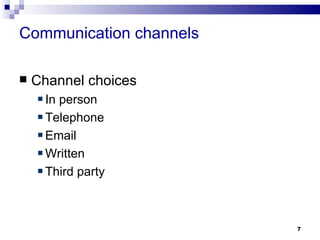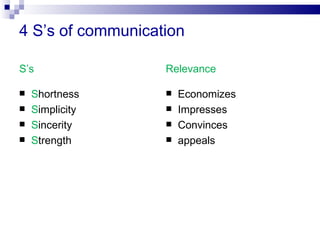Communication skills 2003
- 2. Overview What is communication skills? Elements of communication. Communication process Types of communication. Ways to communicati. Forms of communication. Communication networks Importance of communication. ABC of communication. 7 C’s of communication. 4 S’s of communication.
- 3. What is communication skills? Communication is the art of transmitting information ,ideas ,thoughts from one individual or group to another. Communication constitutes Reading, Writing, Speaking & Listening Skills.
- 5. Elements of communication Sender Encoding Message Channel / medium Receiver Decoding Noise Feedback
- 6. The Communication Process Model 6
- 7. Communication channels Channel choices In person Telephone Email Written Third party 7
- 8. Types of communication 1. Verbal communication Oral Written 2. Non-verbal communication
- 9. Common ways to communicate ages l Im ord V isua en W Spok Bod Written Word y La ngu age
- 10. Forms of communication General & technical Formal & Informal External & Internal Interpersonal & intrapersonal
- 11. Communication networks Vertical network Upward Downward Horizontal network Diagonal network
- 12. Hierarchy levels Executive Director Manager Vice President A.G.M. Supervisor 1 Supervisor 2 Supervisor 3 Manager Supervisor Horizontal Comm. Forman
- 13. Importance of effective communication Saves time Coordinating Collating Issuing instruction Improves listening, speaking and writing skills Convincing Persuading
- 14. Barriers to communication Noise Inappropriate medium Assumptions/Misconceptions Emotions Language differences Poor listening skills Distractions Cultural differences
- 15. ABC of communication Accuracy Brevity Clarity
- 16. 7 C’s of communication C’s Relevance Credibility Builds trusts Courtesy Improves relationships Clarity Makes easy Correctness Builds confidence Consistency Introduces stability Concreteness Reinforces confidence Conciseness Saves time
- 17. 4 S’s of communication S’s Relevance Shortness Economizes Simplicity Impresses Sincerity Convinces Strength appeals
- 18. Success for YOU… …in the new global and diverse workplace requires excellent communication skills!
- 19. Questions


















